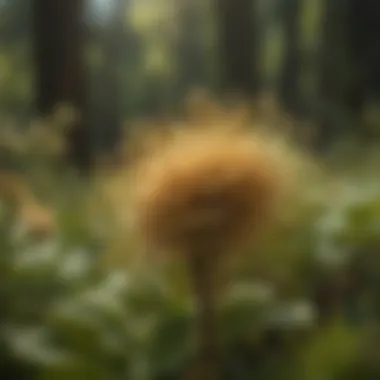Hazel Flowers: Ecology and Cultural Importance


Intro
Hazel flowers play a significant role within woodland ecosystems. Their ecological and cultural importance transcends simple aesthetics, drawing attention from both professionals and enthusiasts alike. This article explores hazel flowers comprehensively, noting their biological characteristics, reproductive strategies, and interactions within their environments.
While many may overlook these flowers, understanding their contribution to biodiversity and sustainable forestry is crucial. The interplay between this plant and its surrounding ecosystem creates a rich tapestry of relationships that are fundamental to woodland health.
Ecologically, hazel flowers support various species and facilitate vital processes within forests. On a cultural level, they hold historical relevance and serve as a symbol in many traditions. The importance of hazel flowers finds a place in contemporary forestry practices, linking natural heritage with sustainable management methods.
The subsequent sections will detail the intricacies of woodland ecosystems, showcase sustainable forestry principles, and discuss stewardship techniques that enhance the growth and preservation of hazel and similar flora.
Prelude to Hazel Flowers
Hazel flowers, often overlooked in the grand landscape of forestry, play a crucial role in both ecological and cultural contexts. Understanding these flowers is essential for those looking to appreciate the complexities of woodland ecosystems. Their contributions span from supporting local wildlife to enriching human culture. Exploring the biological and cultural significance of hazel flowers offers valuable insights into their multifaceted life and environmental interdependence.
Overview of Hazel Species
The term "hazel" primarily refers to several species within the genus Corylus. The most notable among them include Corylus avellana, commonly known as the European hazel, and Corylus americana, which is referred to as the American hazel. These species are characterized by their distinctive catkins—male flowers that emerge in early spring—and their hard-shelled nuts, which are a source of food for various animals.
Hazel trees thrive in temperate climates and can grow in a variety of soils, making them adaptable to many environments. Typically, they are found on the edges of forests and in woodland clearings. This adaptability plays a significant role in their success as a species.
Moreover, their growth patterns contribute to forest dynamics. They can grow both as multi-stemmed shrubs and single-stemmed trees, providing flexible habitat solutions for different wildlife species.
Botanical Characteristics
Hazel flowers share a few distinct botanical features. The male flowers develop into long catkins, which in turn produce pollen. This pollen is critical for fertilizing the female flowers that appear on the same plants but in separate clusters. The female flowers are small and are less conspicuous, resembling tiny red buds. Their reproductive strategy allows for a more extensive pollination period, enhancing genetic diversity.
The leaves of hazel trees are another significant aspect of their botanical profile. They are usually rounded, with serrated edges and veins that make them distinct. In autumn, hazel leaves can display a vibrant array of colors before falling, which contributes to the aesthetic value of the landscape.
Hazel also has a robust root system that stabilizes the soil. This is particularly important in preventing soil erosion in susceptible environments. Overall, the botanical characteristics of hazel flowers provide insights into their ecological value, reflecting their adaptability and resilience.
Biology of Hazel Flowers
The biology of hazel flowers is fundamental to understanding their role within their ecosystems. They offer essential insights into how these plants reproduce and interact with the environment. The reproductive structures and pollination mechanisms are especially pertinent, highlighting the function and significance of hazel flowers in facilitating biodiversity.
Reproductive Structures
Hazel flowers exhibit a distinct anatomy that is optimized for reproduction. The male flowers, known as catkins, appear in clusters and release pollen into the air. Catkins are typically yellow and are often noticeable in early spring. They can be several centimeters in length and cluster in groups of two or more.
The female flowers are more discreet and exist in small, unfurling clusters. Unlike catkins, they develop near the ends of branches. Their structure is designed to capture incoming pollen effectively.
This structural arrangement plays a crucial role in the reproductive cycle:
- Timing: Male catkins release pollen when the female flowers are receptive, which generally align with the early part of spring.
- Appearance: The contrast between the prominent male flowers and the subtlety of the female blooms allows for efficient pollination.
Understanding these reproductive structures is vital. They not only demonstrate how hazel flowers attract pollinators but also how they sustain their populations in woodland environments.


Pollination Mechanisms
Pollination in hazel flowers is primarily carried out by wind, making them anemophilous. The lightweight pollen is dispersed through the air, reaching female flowers efficiently. There are several key factors in this process:
- Environmental Conditions: Pollination is most successful on dry, windy days. These conditions facilitate the transport of pollen.
- Pollen Production: Hazel trees are known for producing a significant amount of pollen. This excess increases the chances of successful fertilization.
- Adaptation Strategy: The reliance on wind pollination may seem limited, but it allows the hazel trees to thrive in dense woodlands where biotic pollinators may be scarce.
Males produce large quantities of pollen, signifying a strategy to enhance reproductive success despite reliance on abiotic factors.
Ecological Importance of Hazel Flowers
Hazel flowers play a pivotal role in ecological systems, particularly in woodland habitats. Their significance extends beyond mere aesthetic value, as they contribute to the well-being of their environment and the various species that inhabit it. This section elucidates the multifaceted ecological roles of hazel flowers, focusing on habitat formation, support for pollinator species, and contributions to biodiversity.
Role in Habitat Formation
Hazel trees, primarily the Corylus avellana, are integral to creating and sustaining diverse habitats. Their presence in woodlands contributes to soil stability, preventing erosion through their extensive root systems. The fallen leaves of hazel trees enrich the organic matter in the soil, fostering a nutrient-dense environment. This not only benefits the hazel itself but also supports a variety of other plant species.
Additionally, hazel flowers provide critical cover and nesting materials for various birds and mammals. Dense stands of hazel can form thickets that serve as shelter for wildlife, enabling them to thrive in a relatively safe environment. For amphibians and small mammals, these habitats provide security from predators, making them vital for the survival of some species.
Support for Pollinator Species
Hazel flowers are among the earliest blooming sources of nectar and pollen in temperate ecosystems, typically flowering before many other plants awaken from winter dormancy. This early availability of resources is crucial for supporting pollinator species, notably bees and other insects that rely on spring blooms.
The flowers, being unisexual, have distinct male and female structures. The male catkins produce pollen, while the female flowers emerge with minimal visibility. Pollinators are drawn to the abundant, easily accessible pollen from the male flowers. In doing so, they facilitate cross-pollination that enhances the genetic diversity of hazel populations, which is vital for their resilience.
Contributions to Biodiversity
The presence of hazel flowers enriches the biological complexity of woodland environments. They serve as a crucial food source for various insects, particularly during the spring months when fewer resources are available. This helps sustain insect populations, which, in turn, are dietary staples for birds and other creatures higher up in the food chain.
Moreover, diverse plant communities, including hazel, support a range of other species. The structural diversity provided by hazel thickets offers habitats for both flora and fauna. The complex relationships established within these ecosystems contribute to overall biodiversity, which is essential for ecological stability.
In summary, the ecological importance of hazel flowers cannot be overstated. They are foundational elements in habitat formation, they support pollinator species by providing essential resources, and they actively contribute to the overall biodiversity that sustains healthy ecosystems. As these environments face emerging threats, recognizing the roles of species such as hazel provides valuable insight into conservation efforts.
Cultural Significance of Hazel Flowers
Hazel flowers carry profound cultural importance, both historically and in contemporary contexts. They are more than just biological specimens; they embody rich traditions and enduring symbolism that span various cultures. Understanding their cultural significance helps illuminate their role beyond the ecological sphere.
Historical Uses and Symbolism
Throughout history, hazel flowers have appeared in numerous cultural narratives and practices. Folklore often associates hazel with wisdom and knowledge. In ancient Celtic traditions, the hazel tree was considered sacred. Many believed that it held mystical properties. Its nuts were seen as symbols of fertility and abundance, while its branches were used in divination rituals.
Moreover, the practice of using hazel in practical applications is notable. Historically, hazel wood was favored for making tools and fishing rods. Its flexible branches made it suitable for crafting relatively lightweight and strong items, often utilized by artisans in various trades. In some regions, evergreens of hazel were traditionally planted as boundary markers, showcasing its relevance beyond mere aesthetics.
- Symbolism:
- Wisdom and knowledge
- Fertility and abundance
- Sacred in ancient cultures


The hazel is also a key figure in many mythological tales. For instance, in Irish mythology, the hazel tree is linked to poetic inspiration. The nuts of the tree were considered to confer wisdom to anyone who consumed them. This intersection of nature and narrative creates a cultural mosaic that continues to resonate in modern society.
In Arts and Literature
The artistic presence of hazel flowers is significant. They have inspired numerous artists and writers over the ages. In literature, hazel flowers frequently appear as symbols of resilience and regeneration. Their early spring bloom serves as a metaphor for new beginnings in various narratives.
- Examples of literary representations include:
- "A Midsummer Night's Dream" by William Shakespeare
- "The Secret Garden" by Frances Hodgson Burnett
Many poems celebrate the hazel's delicate beauty. They capture the simplicity and elegance of the flowers. The aesthetic appeal of these flowers makes them a popular motif in art. Artists often depict hazel trees and flowers to convey tranquility and harmony with nature.
In summary, the cultural significance of hazel flowers is immense. They embody a rich history full of symbolic meanings. Furthermore, they continue to inspire a variety of creative expressions in arts and literature. This underscores the importance of preserving hazel species, for their utility extends far beyond ecological considerations. They hold a position of honor in the collective human experience.
Hazel Flowers in Sustainable Forestry
Hazel flowers play a crucial role in the realm of sustainable forestry. These flowers are not only significant for their ecological functions but also for the benefits they bring to forest management practices. Their contributions can be observed in multiple ways, ensuring that forestry initiatives are both environmentally responsible and economically viable.
Integration into Management Practices
Integrating hazel flowers into forestry management practices offers various advantages. First, they enhance the overall biodiversity of forest ecosystems. By planting hazel trees alongside other species, practitioners can create a more resilient environment, fostering a habitat that supports various animals and plants.
The presence of hazel can also improve soil quality. The nutrients from hazel foliage contribute to the fertility of the ground, benefiting surrounding flora. This symbiosis promotes the growth of other trees, making areas more productive and sustainable in the long term.
Hazel species, such as Corylus avellana, are adaptable and can thrive in diverse soil conditions. This adaptability makes them suitable for reforestation projects, where they can restore degraded areas.
Additionally, hazel flowers are early bloomers, providing essential food sources for pollinators at the onset of spring. Their integration into management can thus support the populations of these vital insects, which are critical for plant reproduction and overall ecosystem health.
Conservation Techniques
Conservation techniques involving hazel flowers focus on preserving both the species and the ecosystems they inhabit. Adaptive management strategies can be employed to monitor the health and growth of hazel populations. This ensures that interventions do not disrupt the existing flora and fauna.
Approaches such as selective thinning—where only certain trees are removed—allow for the continued growth of hazel trees while maintaining forest density. This not only aids in preserving hazel populations but also enhances the resilience of the forest against diseases and pests.
Furthermore, propagating hazel through seed collection and planting initiatives is a proactive strategy in conservation. Educating local communities about the benefits of hazel can foster engagement in conservation efforts. Engaging communities is crucial for the success of sustainable forestry, ensuring that practices are embraced and supported.
"Integrating hazel into forestry not only preserves this species but also enhances the resilience of forest ecosystems."
Challenges Facing Hazel Flowers
The discussion regarding the challenges facing hazel flowers is vital in understanding their future viability and ecological function. As climate change continues to affect numerous ecosystems, hazel flowers are not immune to its far-reaching impacts. Additionally, pest and disease pressures present significant hurdles that could affect their health and reproduction. Addressing these challenges is essential for preserving the role of hazel flowers in both natural ecosystems and human culture.
Threats from Climate Change
Climate change presents a myriad of threats to hazel flowers. As temperatures fluctuate and weather patterns become increasingly erratic, the delicate balance required for these species to thrive is at risk. Changes in temperature can lead to altered flowering times, which may misalign with the life cycles of pollinators that depend on these plants for sustenance.


Furthermore, extreme weather events such as droughts or floods can damage hazel habitats. For instance, prolonged dry spells may hinder the water availability needed for the plants' growth. Additionally, the increased incidence of storms can physically damage the plants, impacting their reproductive success.
The shift in climate also encourages the migration of pests that may have previously been limited to certain regions. Warmer climates allow these pests to thrive, leading to greater infestation rates in hazel populations.
Pest and Disease Impacts
Pest and disease threats are critical concerns for the sustainability of hazel flowers. Various pests, including aphids, can weaken the plants by feeding on their sap. This feeding can lead to stunted growth and decreased flower and nut production.
Moreover, diseases caused by pathogens such as fungi and bacteria can further compromise the health of hazel populations. These diseases might spread more rapidly in changing climates where stress factors, like drought or prolonged wet conditions, are prevalent.
To combat these threats, integrated pest management strategies need to be adopted. This approach encourages the use of multiple tactics that include monitoring pest activities and applying biological controls when necessary. Such proactive measures are crucial to mitigate the impacts of pests and diseases on hazel flowers, thus ensuring their survival in increasingly challenging environments.
"Addressing both climate change and pest impacts is essential for the preservation of hazel flowers and the many species they support."
Emphasizing research on these challenges can guide forest management practices, paving the way for resilient ecosystems that foster the growth and sustainability of hazel flowers.
Research and Future Directions
Research into hazel flowers is critical for comprehending their ecological role and cultural relevance. Understanding how these flowers interact with their environment can lead to better conservation strategies and enhanced sustainable practices. As climate change and habitat destruction threaten natural ecosystems, ongoing studies are vital for developing effective management tactics. These research initiatives not only aim to protect hazel populations but also the myriad species that depend on them.
Current Studies on Hazel Flowers
Currently, various studies focus on the biological and ecological aspects of hazel flowers. This includes examining their reproductive biology, the role they play in sustaining local biodiversity, and their interactions with pollinators. One significant area of focus is Corylus avellana, the common hazel, due to its prevalence in many woodlands.
Researchers are investigating how hazel flowers contribute to habitat stability and support diverse wildlife. For instance, studies have shown that they attract several species of bees, which are crucial for pollination. This interplay between plants and pollinators is essential for maintaining the health of ecosystem.
Furthermore, specific research projects are identifying how hazel flowers are adapted to changing environmental conditions. For example, the effects of fluctuating temperatures and rainfall patterns on flowering times and success rates are being analyzed. The outcomes of these studies may inform strategies to enhance the resilience of hazel populations.
Potential for Genetic Research
The genetic research potential of hazel flowers is notable. Examining genetic variations can provide insight into how these plants adapt to diverse environmental conditions. Analysis of genetic markers may lead to the identification of traits that confer drought resistance or disease tolerance.
Moreover, understanding the genetic diversity in hazel populations can enhance conservation efforts. Targeted genetic studies may uncover specific alleles that enable resilience to pests or climate change, facilitating the selection of individuals for breeding programs aimed at food production or reforestation.
These genetic investigations could also pave the way for biotechnological advances. If researchers identify genes linked to desirable traits, there may be opportunities for developing cultivars optimized for specific environments or uses, significantly benefiting both ecological and agricultural objectives.
In summary, ongoing research into hazel flowers will not only deepen our understanding but also empower us to protect these important species. Collaborative efforts among forestry professionals, academicians, and conservationists will be essential to harness potential findings effectively.
The End
In summary, the conclusion serves as a vital part of any article, and this one is no exception. Hazel flowers play a significant role in both ecological systems and cultural narratives. Their biological traits and interactions with various species enrich ecosystems, maintaining biodiversity and promoting habitat stability. In sustainable forestry, hazel flowers not only contribute to environmental health but also offer aesthetic and functional values essential in managing woodland areas.
Summarizing the Importance of Hazel Flowers
To encapsulate, hazel flowers extend far beyond mere beauty. They demonstrate unique biological adaptations that enable them to thrive in a range of habitats. Their flowers provide essential resources for numerous pollinator species, reinforcing the web of life within their ecosystems. By supporting various insect populations, hazel flowers help maintain healthy soil and nutritious environments for future generations of both flora and fauna. Furthermore, the historical and cultural significance of these flowers cannot be overlooked. They symbolize resilience and continuity—qualities that resonate deeply in human experiences.
Encouraging Community Engagement
Fostering engagement with hazel flowers can have substantial benefits for communities. Understanding their ecological importance empowers individuals to advocate for practices that promote sustainable land use. Community initiatives focused on conservation and education regarding hazel flowers can enhance local biodiversity. Workshops, guided hikes, and educational programs can bridge the gap between knowledge and action. When people connect with their environment through hands-on activities, they cultivate a deeper appreciation for the intricate relationships that compose the natural world.
As this article has illustrated, recognizing the importance of hazel flowers is crucial for both ecologists and community leaders. Emphasizing the need for continued research and community involvement can help ensure a sustainable future for these vital organisms.







